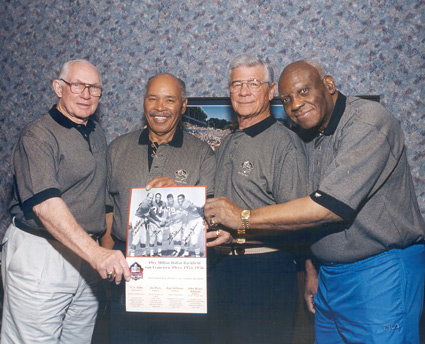Gold mine
6/9/2011
A new "For Pete's Sake" blog appears each Thursday.
There are some football stories that over time grow in stature. In fact I could list a number of accounts that have been embellished into famous tales. There's fact and then there's folklore.
So I started to wonder if that was the case with the San Francisco 49ers' backfield of the 1950s. It's the only complete backfield in history that all of its members were eventually enshrined into the Pro Football Hall of Fame.
It has the nickname. They were called the "Million Dollar Backfield." It has the star power. The players included quarterback Y.A. Tittle, and running backs John Henry Johnson, Hugh McElhenny, and Joe Perry.
Sadly, half of the quartet died in recent weeks. Perry passed away on April 25 and Johnson died last Friday.
I thought I'd jump back to the era in which they made their mark. Were they really that highly touted when they were playing or has the legend grown over the years?
The answer is yes, the "Million Dollar Backfield" was really that spectacular especially during the first season the four greats were together. And, no their story isn't a tale. I'd actually claim that today's football fans don't really know the story. So, here it is.
The 49ers were born in the mid-1940s and competed in the rival All-America Football Conference during the four years it existed from 1946-49. San Fran, along with the Cleveland Browns and the Baltimore Colts, jumped to the NFL in 1950. The Browns who dominated the AAFC continued with success in the NFL and won the league title that first year. The Colts posted a woeful 1-11-0 record and disbanded after just one NFL season (FYI…the current day Colts were formed in 1953.)
Meanwhile, the 49ers were on the rise in the early 1950s and mired in a battle with the Los Angeles Rams and Detroit Lions for supremacy in the NFL's Western Conference. The bread and butter to their attack was the running game. Perry, a holdover from the AAFC days, was firmly entrenched as the leader of the offensive backfield. Tittle was added in 1951 after his Colts folded. In 1952, McElhenny joined Perry to give the 49ers' the league's most potent rushing duo.
Not surprisingly, the San Francisco 49ers led the NFL in rushing in 1952 and 1953. So, you can imagine the excitement when they signed Johnson to join "The Jet" and the "The King" (aka Perry and McElhenny) in 1954. Johnson, who was drafted by the Pittsburgh Steelers one year earlier, had played a season north of the border after he was lured to the Canadian Football League by the Calgary Stampeders.

It took virtually no time for the already dominant 49ers backfield to gain even greater fame. Johnson's explosion onto the NFL scene included this description from a L.A. Times columnist prior to a 1954 exhibition game.
"Come Friday night in the Coliseum the Rams may be chasing the best offensive back in the National Football League … and I don't mean Hugh McElhenny or Joe Perry. Expert testimony to the greatness of the 49er rookie John Henry Johnson is overwhelming. He is guilty, on all counts, of being a holy terror on the gridiron."
Other newspapers used terms like "rip-snorting terror." Long-time Hall of Fame coach Curly Lambeau, then coach of the Washington Redskins, called Johnson's 51-yard TD run against his team "one of the greatest I've ever seen." Reports indicate that Johnson eluded, or more than likely bowled over, seven Washington tacklers on the run.
John Henry and Perry combined for an impressive one-two punch that first season as the 49ers led the NFL in rushing for a third straight time by racking up 2,498 total rushing yards. Perry made history by becoming the first runner to record consecutive 1,000-yard seasons. Johnson posted a healthy 618 yards and 9 TDs in his first NFL campaign to finish second. Not far behind was McElhenny, who despite missing the last six games of the season with injuries, finished eighth overall with 515 yards. Perhaps the real story of the "Million Dollar Backfield" was their rich yards per carry average. McElhenny led the league in that category as he had just 64 carries which equated to 8 yards every time he rushed the football. Perry posted a strong 6.1 yards per rush while Johnson averaged 5.3 yards a carry. Tittle was starting to come into his own at the time and quickly made his way to the upper echelon of quarterbacks.
As one can imagine, it was difficult to keep that much talent together as there are only so many plays in a game. In all, the "Million Dollar Backfield" was together for three seasons. Johnson, who only played exclusively on offense that first year and battled injuries in 1955, eventually was dealt to the Detroit Lions in May 1957. He led Detroit to their last NFL title that year. He moved on to Pittsburgh shortly thereafter and enjoyed his finest years with the Steelers.
Certainly time gained the "Million Dollar Backfield" more fame but that only makes sense. Regarded as potent at the time, the true understanding of how extraordinary the 49er backfield was could only be measured after looking at each individual's total body of work on the football field. That is what earned each of them bronze busts in Canton (Perry in 1969, McElhenny in 1970, Tittle in 1971, and Johnson finally in 1987). Today, the literal meaning of a "Million Dollar Backfield" is commonplace for all NFL teams. But, even in the age of free agency, it's hard to imagine any team ever having a backfield like the 49ers had for that brief moment in time.
The "Million Dollar Backfield" reunited for their first ever autograph session as a group during an appearance at the Hall of Fame on May 8, 1999. Here's a shot from that day.

Go back to all blog listings